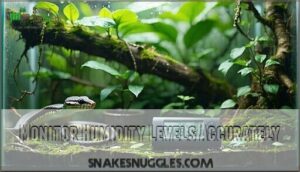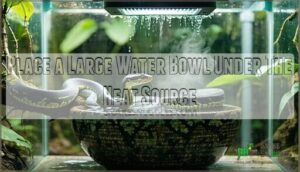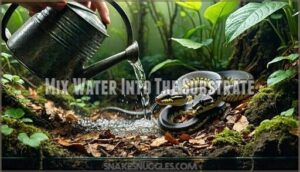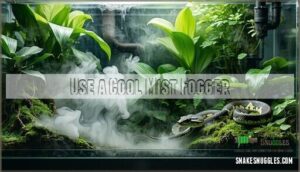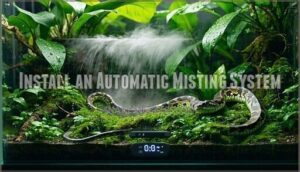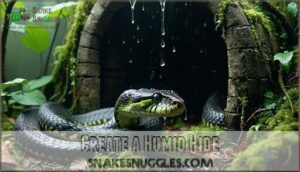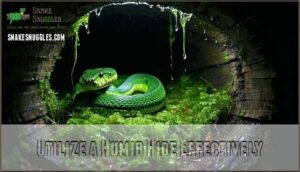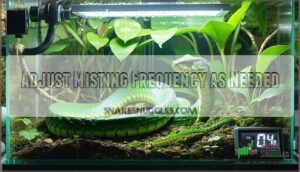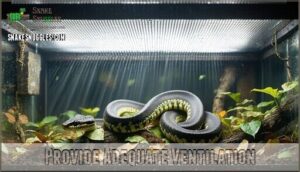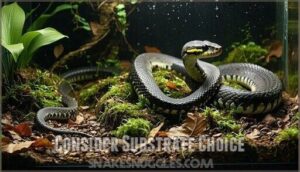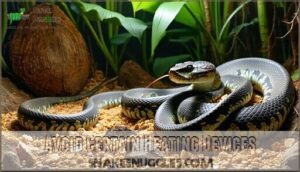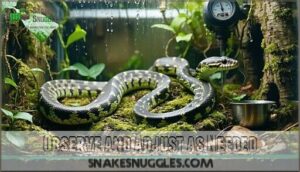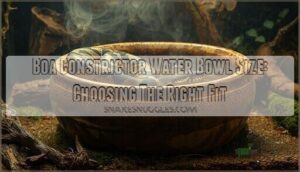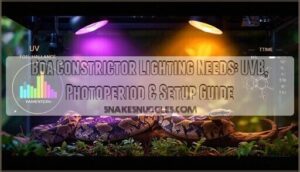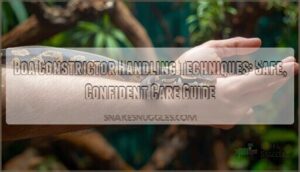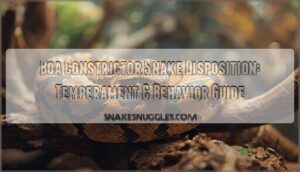This site is supported by our readers. We may earn a commission, at no cost to you, if you purchase through links.
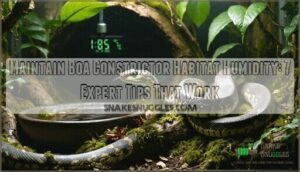
Place a large water bowl under the heat source to boost moisture, or mix water into the substrate for added retention. A humid hide lined with damp sphagnum moss can work wonders, especially during shedding.
Avoid cheap analog gauges—they’re as unreliable as a broken clock. Good ventilation is key, so don’t seal the enclosure too tightly.
If needed, try a misting system or cool mist fogger. Remember, small adjustments go a long way in keeping your snake comfortable and healthy. Curious about substrates? Keep reading!
Table Of Contents
- Key Takeaways
- Understand The Optimal Humidity Range
- Monitor Humidity Levels Accurately
- Increase Humidity Through Various Methods
- Utilize a Humid Hide Effectively
- Maintain Proper Water Quality
- Adjust Misting Frequency as Needed
- Provide Adequate Ventilation
- Consider Substrate Choice
- Avoid Certain Heating Devices
- Observe and Adjust as Needed
- Frequently Asked Questions (FAQs)
- How do I keep the humidity in my boa tank?
- What humidity should a boa constrictor habitat be?
- How to increase boa humidity?
- What is the ideal humidity for BCI?
- How to keep a boa enclosure humid?
- How much humidity does a boa constrictor need?
- What are special habitat considerations for a boa?
- Do boas need heat at night?
- How to keep a boa constrictor humid?
- How much humidity should a boa enclosure have?
- Conclusion
Key Takeaways
- Keep humidity between 55-75% using a reliable digital hygrometer and make small adjustments to maintain balance.
- Use methods like misting, a large water bowl under heat, or a humid hide with damp sphagnum moss to boost moisture.
- Avoid cheap analog gauges and ensure proper ventilation to prevent mold and stagnant air.
- Monitor regularly and adjust based on shedding patterns or behavior changes to keep your boa comfortable and healthy.
Understand The Optimal Humidity Range
You’ll need to maintain humidity levels between 55-75% for your boa constrictor’s ideal health and comfort.
This range mimics their natural tropical habitat and prevents shedding problems, respiratory issues, and dehydration that occur when humidity drops too low, ensuring the boa’s overall health.
Ideal Humidity: 55-75%
For boa constrictor humidity levels, you’ll want to maintain 55-75% in your snake’s habitat.
This optimal range benefits your boa’s respiratory health and shedding process.
Consistent humidity importance can’t be overstated – it prevents dehydration and skin problems.
Gradient advantages mean creating zones with slightly different moisture levels throughout the enclosure.
This boa constrictor care approach mimics their natural environment perfectly.
Occasional High Humidity (up to 85%) Can Aid Shedding
Humidity spikes reaching 85% transform your boa constrictor’s shedding process from struggle to success.
During shedding duration, elevated moisture prevents retained eyecaps and promotes complete skin health.
You’ll need to monitor shedding frequency and adjust humidity levels accordingly.
Use sphagnum moss and strategic misting to create these temporary boosts in your snake habitat humidity.
This targeted approach guarantees your boa constrictor humidity supports the natural snake shedding process without constant elevation.
Humidity Gradients and Fluctuations Are Better Than Constant Humidity
Creating varying humidity zones mimics your boa constrictor’s natural rainforest home better than maintaining constant levels.
These gradients offer Natural Simulation while providing Gradient Benefits like Mold Prevention and Behavioral Enrichment. Your snake can choose preferred moisture zones, leading to Healthier Sheds when humidity monitoring shows proper fluctuations.
- Humidity levels should vary between 55-75% across the enclosure
- Place water bowls in warmer areas for higher local humidity
- Cool zones naturally maintain lower moisture levels
- Boa humidity levels can spike safely to 85% during shedding
Fluctuations prevent stagnant air and bacterial growth
Monitor Humidity Levels Accurately
You can’t maintain proper humidity levels if you don’t measure them accurately with the right tools.
Accurate tools are the secret to perfect humidity—don’t guess when your boa’s health depends on precision.
Digital hygrometers provide precise readings that help you create the perfect environment for your boa’s health and successful shedding.
Avoid Cheap Analog Humidity Gauges
Those stick-on analog humidity gauges are like fortune cookies—they might look official, but you can’t trust their predictions.
Analog inaccuracy plagues these cheap devices, delivering inaccurate readings that put your boa’s health at risk.
They’re notorious for drifting off-target without warning, making reliable humidity monitoring nearly impossible.
Don’t gamble with your snake’s well-being by relying on outdated technology.
Your boa deserves better than guesswork when maintaining proper humidity levels in their habitat.
Use a Reliable Digital Hygrometer for Precise Measurements
Analog gauges often provide wildly inaccurate readings that’ll leave you guessing. Digital hygrometer accuracy makes all the difference for proper boa constrictor care.
These devices give you precise humidity measurements you can actually trust. As seen with reptile product sales, many options are available for purchase.
Hygrometer placement matters – position it at your snake’s level, not near heat sources. Regular calibration importance can’t be overstated for reliable data.
Check your device monthly and replace batteries as needed. Hygrometer maintenance and proper data interpretation help you maintain ideal reptile enclosure humidity levels consistently.
Increase Humidity Through Various Methods
You can raise humidity in your boa’s enclosure using several proven methods that work together or separately.
These techniques range from simple water bowl adjustments to automated systems that maintain consistent moisture levels throughout the habitat, utilizing proven methods to achieve the desired environment.
Place a Large Water Bowl Under The Heat Source
You can boost your boa constrictor’s humidity by positioning a large water bowl directly under the heat source.
This simple setup increases the evaporation rate substantially.
- Water Bowl Size: Use bowls that hold at least 32 ounces
- Heat Source Type: Works best with ceramic heaters or heat lamps
- Water Temperature: Aim for 80-85°F for ideal evaporation
- Enclosure Material: Glass tanks retain moisture better than mesh tops
Mix Water Into The Substrate
Another effective approach involves directly adding water to your boa’s substrate.
This mixing technique creates moisture pockets that gradually release humidity throughout the enclosure.
You’ll want to spray or pour small amounts of clean water into substrate corners, avoiding oversaturation that leads to mold growth.
This method helps maintain consistent substrate moisture levels while supporting proper snake shedding cycles naturally, which is crucial for the snake’s health and involves a shedding cycle.
Use a Cool Mist Fogger
Cool mist foggers create fine water droplets that boost your boa’s humidity without overheating the enclosure. Position your reptile fogger at the cool end to establish a proper humidity gradient.
Set timer settings for 10-15 minute sessions twice daily, adjusting based on your hygrometer readings. Water quality matters—use distilled water to prevent mineral buildup.
You can find a variety of options online. Follow a weekly maintenance schedule by cleaning the unit thoroughly.
This humidity control method works great for consistent misting without constant monitoring, making fogger placement your key to success.
Install an Automatic Misting System
Professional automatic misting systems deliver precise humidity control for your boa constrictor’s habitat.
These systems spray fine water droplets at programmed intervals, maintaining ideal moisture levels without constant manual intervention.
Digital controllers let you adjust timer settings based on your snake’s specific needs and seasonal changes.
To find the best option, consider an automatic reptile mister for consistent humidity.
Key components for effective humidity monitoring include:
- High-pressure pumps creating 500-1000 micron droplets
- Strategic nozzle placement 12-18 inches above substrate
- Stainless steel nozzles resisting corrosion
- Programmable timers mimicking natural cycles
- Water source filtration preventing contamination
Regular maintenance schedule guarantees reliable misting system performance.
Create a Humid Hide
Set up a humidity box on the cool end of your boa constrictor’s enclosure.
Use a proper hide size lined with damp sphagnum moss or similar moss types.
This setup mimics natural conditions, helping with shedding and overall snake care.
Regularly check the maintenance schedule to keep it clean and moist.
Remember, location matters for maintaining ideal humidity for boas!
Utilize a Humid Hide Effectively
A humid hide is a simple yet effective way to maintain proper humidity for your boa constrictor, especially during shedding.
A humid hide is your boa’s personal spa, ensuring smooth shedding and perfect hydration for a stress-free experience.
By lining a hide with damp sphagnum moss, you create a microenvironment that supports healthy skin and hydration, which is a key factor in a boa constrictor’s overall health.
Line a Reptile Hide With Damp Sphagnum Moss
A humid hide is a game-changer for maintaining proper humidity for boas.
Here’s how you can set it up:
- Choose a sturdy hide material and fill it with damp sphagnum moss, a top moss type for water retention.
- Position it on the cool side to match snake preferences.
- Stick to a maintenance schedule—replace moss often to avoid mold.
- Mist regularly to maintain a consistent humidity gradient inside the hide, which is crucial for creating a humidity gradient.
Especially Helpful During The Snake’s Shedding Process
During shedding, a humid hide becomes your boa constrictor’s best friend.
Damp sphagnum moss inside helps maintain the higher humidity (75-85%) needed for smooth shedding.
This prevents issues like retained eyecaps or skin wrinkling.
Watch your snake’s shedding behavior closely—proper hydration and humidity are key.
Think of it as their personal spa for stress-free shedding!
Snakes require periodic skin replacement to accommodate growth.
Maintain Proper Water Quality
Water quality plays a big role in keeping your boa healthy and hydrated.
Tap water might seem convenient, but its high mineral content can lead to residue buildup in the water bowl and enclosure. Stick to dechlorinated or reverse osmosis water for a safer, cleaner option that mimics their natural environment.
Here’s how to maintain high-quality water quality:
- Change water frequently: Replace the water daily to keep it fresh and appealing.
- Clean the bowl regularly: Scrub it to remove bacteria, algae, or any slime buildup.
- Watch for residue: If you notice mineral deposits, swap out the bowl or clean thoroughly.
- Place the bowl wisely: Position it under a heat source to naturally boost humidity.
By keeping the water source clean and consistent, you’ll support hydration and reduce risks of dehydration or shedding issues.
Using sturdy bowls prevents snakes from tipping them over.
Adjust Misting Frequency as Needed
To keep your boa constrictor happy and healthy, adjust your misting schedule based on its needs and environmental factors.
Use a reliable digital hygrometer to monitor humidity levels—aim for 55-75%, but brief humidity spikes up to 85% during the shedding cycle are fine.
If parts of the enclosure seem too dry, increase misting frequency slightly. Too wet? Dial it back to prevent mold.
Humidity gradients are key. By misting strategically, you can create zones with varying moisture levels, mimicking the snake’s natural habitat.
Pair misting with heat sources like basking bulbs to guarantee moisture evaporates evenly. For added control, mix moisture-retaining substrates like coconut fiber or leaf litter into the bedding.
Remember, balance is everything—your boa thrives in that "just right" sweet spot, not a rainforest flood! Maintaining the right humidity can also prevent common snake health issues.
Provide Adequate Ventilation
Good ventilation is key to maintaining a healthy boa constrictor environment.
Without proper airflow, humidity can become unbalanced, and stagnant air may lead to mold and mildew—serious threats to your snake’s health. Think of ventilation as your enclosure’s lungs, keeping things fresh and breathable.
To guarantee proper airflow, use cage materials like screen tops or enclosures with built-in vents. Adjust these ventilation methods to find the right humidity balance for your boa enclosure setup.
For example, partially covering the screen can help retain moisture while still allowing air circulation. Always monitor the enclosure to prevent over-humidifying or drying it out.
A well-ventilated boa constrictor environment promotes both mold prevention and a comfortable, breathable habitat for your snake.
Consider Substrate Choice
Choosing the right substrate plays a big role in maintaining proper humidity for your boa constrictor.
Materials like coconut fiber or sphagnum moss hold moisture well, helping to keep the enclosure at ideal levels.
Benefits of Natural Substrate
Natural substrate offers more than just moisture retention for your boa constrictor.
It supports a microbial ecosystem, controls odors, and mimics their natural burrowing behavior. Plus, it’s great for enrichment and texture.
Here’s why it’s a smart choice:
- Encourages digging and natural behaviors.
- Enhances planted vivarium potential.
- Maintains humidity while adding a naturalistic touch.
Consider substrates like cypress mulch bedding for humidity control.
Moisture Retention Capabilities
Choosing the right substrate is like finding the perfect sponge for your boa’s habitat.
Coconut fiber or cypress mulch excels at holding moisture, meeting boa humidity requirements.
A 2-3 inch layer balances evaporation rates and keeps the snake enclosure humidity stable.
Substrate composition also impacts ventilation and temperature gradient, ensuring proper boa humidity.
Remember, humidity and boas go hand-in-hand for their health and shedding ease.
Avoid Certain Heating Devices
When setting up your boa constrictor’s enclosure, steer clear of heating devices like Hot Rocks, Heat Coils, or Unregulated Bulbs. These can create dangerous hot spots and cause severe burns if your snake comes into Direct Contact.
Such devices often lack proper temperature regulation, leading to uneven heat distribution and unpredictable thermal spikes.
Instead, opt for safer alternatives like ceramic heat emitters or radiant heat panels. These provide consistent warmth without compromising your boa’s humidity levels.
Overheating the substrate with improper devices can dry out the enclosure, disrupting the delicate balance of your snake’s habitat.
Always use a thermostat to control artificial heat sources and prevent burn risks. Remember, maintaining stable temperatures and humidity is essential for your boa constrictor’s health.
A well-regulated enclosure mimics their natural environment, reducing stress and ensuring their comfort. Your snake deserves a cozy, safe home—skip the risky gadgets!
Observe and Adjust as Needed
In the case of your boa constrictor’s habitat, keeping an eye on humidity levels is like fine-tuning an instrument—it’s all about balance.
Regularly check for shedding patterns, hydration signs, and skin condition to spot any issues early. Adjust humidity as needed to prevent respiratory issues or mold.
- Increase misting if shedding looks patchy or skin appears dull.
- Reduce humidity if you notice condensation or excessive water bowl use.
- Keep a humid hide ready, especially during shedding cycles.
Behavior changes, like soaking more often, can signal humidity problems. Stay vigilant, and your boa will thrive in a comfortable, healthy environment.
Frequently Asked Questions (FAQs)
How do I keep the humidity in my boa tank?
Think of your boa’s tank as a mini rainforest—it needs consistent moisture.
Mist daily, use damp bedding like moss, place a water bowl under heat, and monitor levels with a digital hygrometer for accuracy.
What humidity should a boa constrictor habitat be?
Your boa constrictor’s habitat should stay between 60-80% humidity.
This range mimics their tropical origins, ensuring hydration and smooth shedding.
Use a hygrometer to monitor levels, as too little or too much can cause health issues, particularly affecting their hydration.
How to increase boa humidity?
Boost humidity by misting the enclosure daily, adding a large water bowl under a heat source, or using damp moss.
A humid hide or a reptile fogger also works wonders for consistent moisture levels.
What is the ideal humidity for BCI?
Picture a rainforest’s damp embrace—your BCI thrives with 60-80% humidity.
Too dry, they’ll struggle to shed; too wet, they risk infections.
Keep it balanced, using a hygrometer, for a healthy, happy snake!
How to keep a boa enclosure humid?
Mist daily, add a large water bowl near the heat source, and use damp substrates like coconut fiber.
A humid hide with moss works wonders.
Monitor humidity with a digital hygrometer to stay precise.
How much humidity does a boa constrictor need?
Your boa constrictor thrives in 60-80% humidity, mimicking its tropical roots.
Keep it steady to prevent dehydration or shedding issues.
A hygrometer helps monitor levels, ensuring your snake stays healthy and stress-free.
What are special habitat considerations for a boa?
Think of their habitat like a tropical spa—warm, cozy, and humid.
You’ll need a secure enclosure, proper heating, consistent humidity, and hiding spots to mimic their natural rainforest environment and keep them stress-free.
Do boas need heat at night?
Boas typically don’t need extra heat at night if room temperatures stay between 75-80°F.
However, if it dips below that, a low-wattage heat source like a ceramic heater guarantees they stay cozy and healthy.
How to keep a boa constrictor humid?
To keep your boa humid, mist the enclosure daily, use damp substrate like coconut fiber, and add a large water bowl near a heat source.
A hygrometer guarantees humidity stays between 60-80% consistently.
How much humidity should a boa enclosure have?
Humidity in a boa’s enclosure should be 60-80%.
It’s like creating a tropical rainforest vibe—just enough moisture to guarantee healthy skin and shedding, but not so much that it feels like a swamp.
Conclusion
Think of maintaining boa constrictor habitat humidity like fine-tuning an instrument—it takes precision and care.
By keeping levels between 55-75%, using tools like digital hygrometers, and employing methods like humid hides or misting systems, you’ll create a comfortable environment for your snake.
Don’t forget proper ventilation and substrate choice to balance moisture and airflow.
Small adjustments make a big difference, so monitor often and adapt as needed.
Your snake’s health and happiness depend on it!

